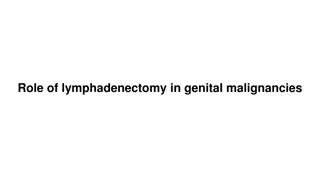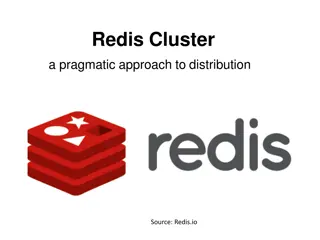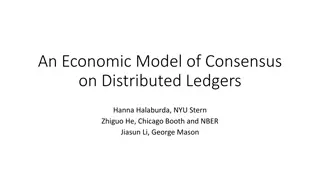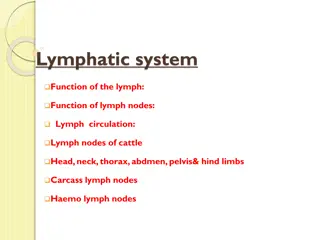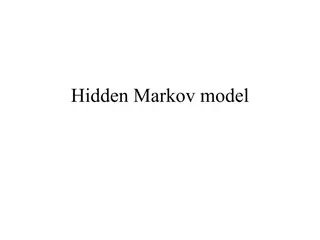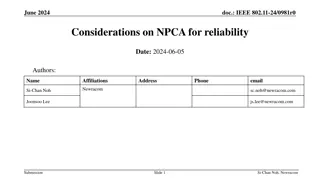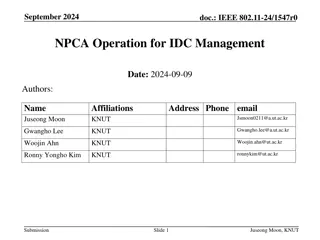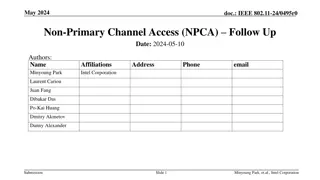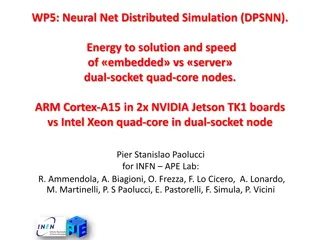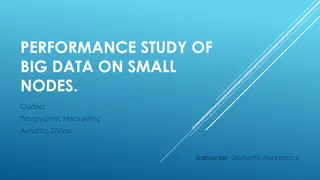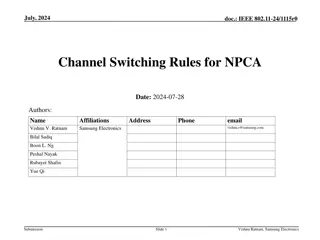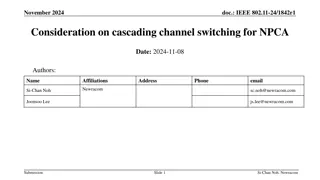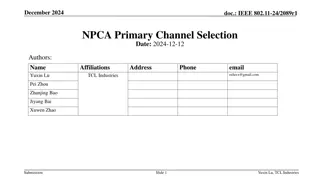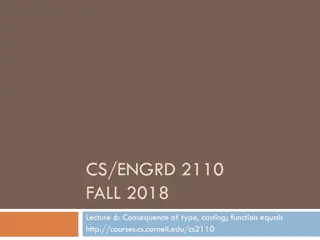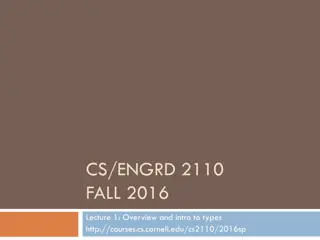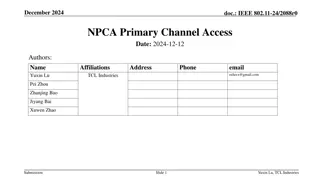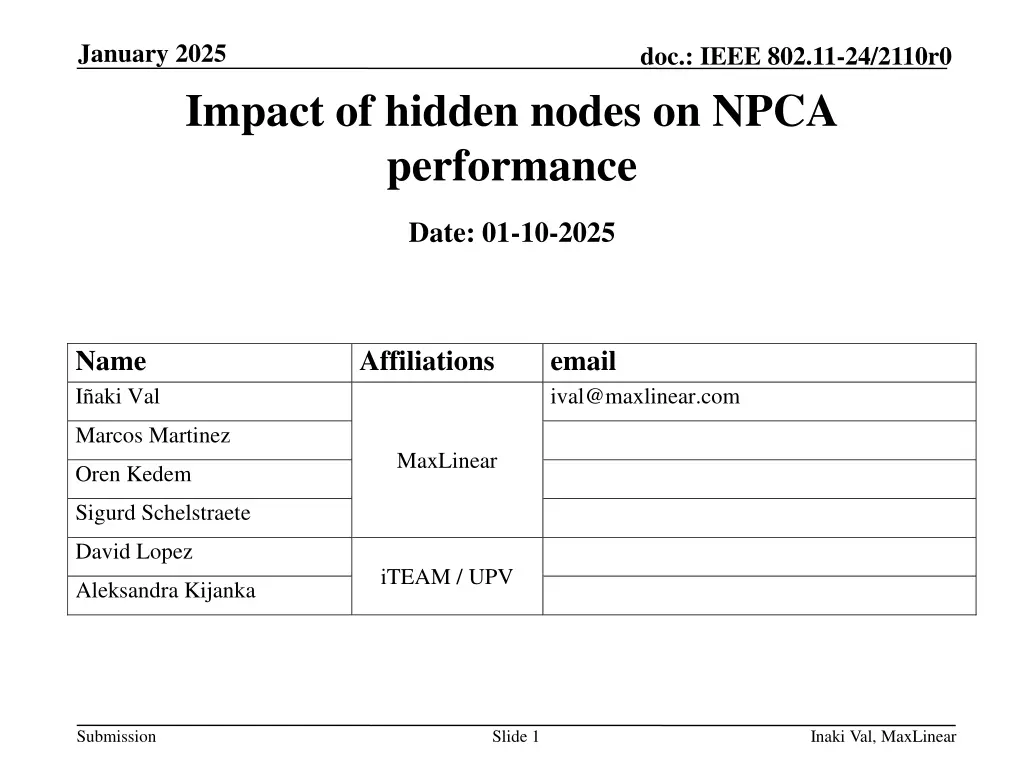
Impact of Hidden Nodes on Non-Primary Channel Access (NPCA) Performance in IEEE 802.11bn
Explore the impact of hidden node situations on the performance of Non-Primary Channel Access (NPCA) mechanism in IEEE 802.11bn networks. The study analyzes how hidden nodes affect the decision-making process for switching channels and its implications on network efficiency and reliability.
Download Presentation

Please find below an Image/Link to download the presentation.
The content on the website is provided AS IS for your information and personal use only. It may not be sold, licensed, or shared on other websites without obtaining consent from the author. If you encounter any issues during the download, it is possible that the publisher has removed the file from their server.
You are allowed to download the files provided on this website for personal or commercial use, subject to the condition that they are used lawfully. All files are the property of their respective owners.
The content on the website is provided AS IS for your information and personal use only. It may not be sold, licensed, or shared on other websites without obtaining consent from the author.
E N D
Presentation Transcript
January 2025 doc.: IEEE 802.11-24/2110r0 Impact of hidden nodes on NPCA performance Date: 01-10-2025 Name I aki Val Affiliations email ival@maxlinear.com Marcos Martinez MaxLinear Oren Kedem Sigurd Schelstraete David Lopez iTEAM / UPV Aleksandra Kijanka Submission Slide 1 Inaki Val, MaxLinear
January 2025 doc.: IEEE 802.11-24/2110r0 Introduction 802.11bn targets the improvement of packet delivery by reducing the transmission latency and enhancing network reliability [1] Non-Primary Channel Access (NPCA) mechanism has been adopted to be part of the 802.11bn amendment [2] NPCA leverages the secondary channel, while an OBSS is using the primary channel, allowing the BSS of interest to gain additional resources to improve its own network performance Submission Slide 2 Inaki Val, MaxLinear
January 2025 doc.: IEEE 802.11-24/2110r0 Motivation A correct operation of NPCA implies that the AP and its associated STAs decide to jump all together to the non- primary channel, as consequence of seeing the same external OBSS events (e.g., RTS-CTS sequence) Hidden node situations may create different views of those events within the members of the BSS of interest This contribution analyzes the performance impact on these hidden node situations, covering several deployment setups Submission Slide 3 Inaki Val, MaxLinear
January 2025 doc.: IEEE 802.11-24/2110r0 NPCA: Recap Same primary BSS OBSS OBSS Time RTS DL/UL Exchanges CTS Time NPCA BSS RTS RTS DL/UL Exchanges DL/UL Exchanges CTS CTS BSS returns to the primary channel BSS jumps to the non-primary channel The BSS of interest detects the OBSS RTS/CTS sequence, identifies the OBSS TXOP length, and determines if they can trigger NPCA Proper BSS operation of NCPA requires R1: Joint operation for changing to the non-primary channel R2: Joint operation for returning to the primary channel, before the OBSS ends the TXOP, and guarantee fairness re-accessing to the primary channel Submission Slide 4 Inaki Val, MaxLinear
January 2025 doc.: IEEE 802.11-24/2110r0 General Simulation Assumptions AP and STAs initiate a TXOP using RTS/CTS frames NPCA is triggered by listening to an OBSS RTS/CTS sequence, using a minimum TXOP length threshold of 2ms to take the decision of enabling NPCA In the primary channel, the non-AP STAs generate triggered and untriggered UL traffic In the non-primary channel, the non-AP STAs generate triggered UL traffic Assume there is no switching delay for changing the channel EDCA parameters based on 802.11REVme (Table 9-194) For primary and non-primary channel access Submission Slide 5 Inaki Val, MaxLinear
January 2025 doc.: IEEE 802.11-24/2110r0 Simulation Setup Simulations cover OBSS scenarios under different deployment circumstances, mainly focused on hidden node situations Two independent BSSs, in the same primary channel, each one is composed of one AP and 3 non-AP STAs BSS1 is NPCA capable Data traffic per non-AP STA for both BSSs: UDP DL: 150Mps UDP UL: 20 Mbps STA11 STA22 STA13 BSS1 STA23 AP1 AP2 80 MHz BSS2 160 MHz STA21 STA12 Submission Slide 6 Inaki Val, MaxLinear
January 2025 doc.: IEEE 802.11-24/2110r0 NPCA Simulation Results Attending to the requirement R1 (see slide 4) of changing jointly to the non-primary channel, we have defined several scenario deployments: No hidden nodes scenario (baseline) Shown in this slide Different hidden node use cases Under ideal circumstance where all the STAs see each other, the performance gain for the NPCA BSS (BSS1) is clear, while BSS2 has no performance impact, keeping the fairness Submission Slide 7 Inaki Val, MaxLinear
January 2025 doc.: IEEE 802.11-24/2110r0 Simulation Results Hidden nodes A APs do not see each other The non-AP STAs see all the OBSS network NPCA behavior (BSS1): Non-AP STAs jump to the non- primary channel AP does not see BSS2 RTS/CTS exchange NPCA has no impact on the BSS1 performance Submission Slide 8 Inaki Val, MaxLinear
January 2025 doc.: IEEE 802.11-24/2110r0 Simulation Results Hidden nodes B APs see each other APs do not see OBSS non-AP STAs Non-AP STAs do not see OBSS STAs and AP NPCA behavior (BSS1): None of the BSS1 nodes see BSS2 RTS/CTS exchange NPCA has no impact on the BSS1 performance Submission Slide 9 Inaki Val, MaxLinear
January 2025 doc.: IEEE 802.11-24/2110r0 Simulation Results Hidden nodes C APs see each other APs see OBSS non-AP STAs Non-AP STAs do not see OBSS non-AP STAs NPCA behavior (BSS1): Non-AP STAs do not see BSS2 RTS/CTS exchange AP jumps to the non-primary channel NPCA has no impact on the BSS1 performance Submission Slide 10 Inaki Val, MaxLinear
January 2025 doc.: IEEE 802.11-24/2110r0 Simulation Results Hidden nodes D APs see each other APs see part of the OBSS non-AP STAs (STAx1) Part of non-AP STAs do not see OBSS non-AP STAs and AP NPCA behavior (BSS1): Only AP and STA11 jump to the non- primary channel For this specific case, NPCA has no impact on the BSS1 performance It would help if AP1 knows the non-STAs that have jumped to the non-primary channel A mechanism should be included where [3] could be the starting point Submission Slide 11 Inaki Val, MaxLinear
January 2025 doc.: IEEE 802.11-24/2110r0 Additional Simulation Results Attending to the requirement R2 (see slide 4) of returning jointly to the primary channel, we introduce the CF-End mechanism in the OBSS network The OBSS may end prematurely its TXOP, while the NPCA BSS is not aware of that CF-End OBSS Time RTS RTS DL/UL Exchanges DL/UL Exchanges CTS CTS BSS does not receive CF-End Time NPCA BSS RTS RTS DL/UL Exchanges CTS CTS BSS returns to the busy primary channel BSS jumps to the non-primary channel BSS may start contending The NPCA BSS needs to wait until the primary channel is free again, creating a problem of fairness Submission Slide 12 Inaki Val, MaxLinear
January 2025 doc.: IEEE 802.11-24/2110r0 Additional Simulation Results The ideal scenario (no hidden nodes) may experiment a performance loss due to bad medium synchronization at the returning phase The performance loss is directly related to the traffic load in the OBSS network and the declared TXOP length at the initial RTS-CTS exchange (i.e., real TXOP versus initial scheduled TXOP) The hidden node scenario adds uncertainty, creating discoordination within the NPCA BSS (i.e., some STAs receive the CF-End frame, others continue in the non-primary channel) Even if there was no impact on the NPCA BSS performance, under the presence of CF-End frames it can be worse Submission Slide 13 Inaki Val, MaxLinear
January 2025 doc.: IEEE 802.11-24/2110r0 Additional Simulation Results Hidden node scenario A Hidden node scenario B Hidden node scenario C Hidden node scenario D Submission Slide 14 Inaki Val, MaxLinear
January 2025 doc.: IEEE 802.11-24/2110r0 NPCA Simulation Results - Summary NPCA improves the network performance under an ideal scenario (without hidden nodes) The introduction of hidden nodes under different scenarios, as expected, shows that NPCA has no impact on performance improvement However, if the OBSS introduces a mechanism to terminate prematurely the ongoing TXOP, the performance may be worse Submission Slide 15 Inaki Val, MaxLinear
September 2024 doc.: IEEE 802.11-24/2110r0 Conclusion We have presented simulation results for NPCA mechanism, focusing on the performance impact for those scenarios with hidden nodes We need to be aware about the NPCA performance issues under realistic scenarios, such as the ones related to hidden nodes Even if the performance is not impacted, this is not the case when the OBSS ends prematurely the TXOP, which may occur Submission Slide 16 Inaki Val, MaxLinear
September 2024 doc.: IEEE 802.11-24/2110r0 References [1] IEEE 802.11-23/0028r6, UHR PAR discussion [2] Matthew Fischer et al., PDT MAC NPCA , 24/1762r14 [3] Minyoung Park et al., Non-Primary Channel Access (NPCA) , 23/2005r1 Submission Slide 17 Inaki Val, MaxLinear
January 2025 doc.: IEEE 802.11-24/2110r0 Backup Submission Slide 18 Inaki Val, MaxLinear

